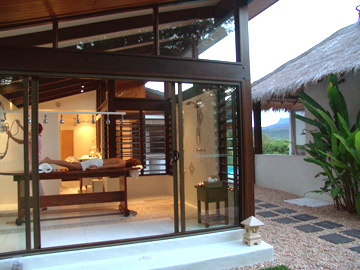Water has been used as a source of healing since ancient times. Ancient Roman public bath houses included baths and steam rooms and was a place where people would relax and socialize, and the mineral springs of Spa, Belgium became a place of healing and health as early as the 14th century. Even the word “spa” originates from the Latin phrase “Salvs per aquae” which translates to “healing through water.” The benefits of bathing in hot springs has been well known for centuries and help us to relax tired muscles, heal skin ailments, and can even be drunk as a tonic to cleanse the body. Many modern European spas still incorporate water and hydrotherapy as a vital part of wellness and the spa experience, while in the United States water therapies tend to be viewed as a luxury. Adding hydrotherapy to your spa is a great way to enhance your spa services and add value to your business. A relaxing mineral soak, steam treatment, or Swiss shower before a massage treatment helps to relax the muscles for your clients and rid the body of impurities. Your spa patrons will leave feeling more relaxed and rejuvenated with the addition of these healing therapies.
Let’s a do a quick rundown of water therapies used in the spa. The first and most well known are the Greek, Roman, and Turkish bath houses. In these bath houses patrons would go through steam or sauna rooms with gradually increasing heat, then cool off in a cold room at the end. They would then receive a massage and scrub down, and relax in a warm room before leaving. These bath houses were places to socialize and unwind, and were the beginning of today’s modern spa treatments.
Today the traditional bath house treatments have been reinterpreted into water journeys and wellness resorts. In a water journey spa-goers travel through pools, steam rooms, saunas, and spa showers with varying temperatures and massage therapies. They are then treated to the massage of their choice. Wellness resorts built near hot springs featuring soaking pools and various wellness treatments using natural remedies can be found throughout the world. They are especially popular in Germany where people escape the daily grind to rejuvenate or seek physical therapy in what they called the “kur”.
Swiss and Vichy showers were developed at the spas near the natural springs in Switzerland and France. Swiss showers feature and overhead shower and vertical shower heads that alternate warm and cold water for an invigorating experience. Vichy showers are mounted horizontally above a bed on which the client lays face down and simulates rain fall. Vichy showers and Swiss showers are gaining popularity in the United States and when done correctly are a fantastic addition to spa services. Depending on where your spa is located these showers can be used with mineral spring water or warmed sea water to add even more restorative properties to the treatment.
The simplest way to add hydrotherapy to your spa is with a soaking tub or whirlpool. With this simple addition you can create dozens of beneficial treatments. Herbal baths like the Krauter bath sooth aches and pains, while dips in hot and cold baths cleanse the body and strengthen the immune system. Spas also add dead sea salts or mineral salts, and even have entire baths of warm mineral or sea water. Jetted tubs offer the additional benefit of massage to the bathing experience.
The health benefits and calming affects of water treatments can’t be denied, and adding hydrotherapy is a great way to add variety to your spa menu. What great hydrotherapy treatments have you incorporated into your spa?







